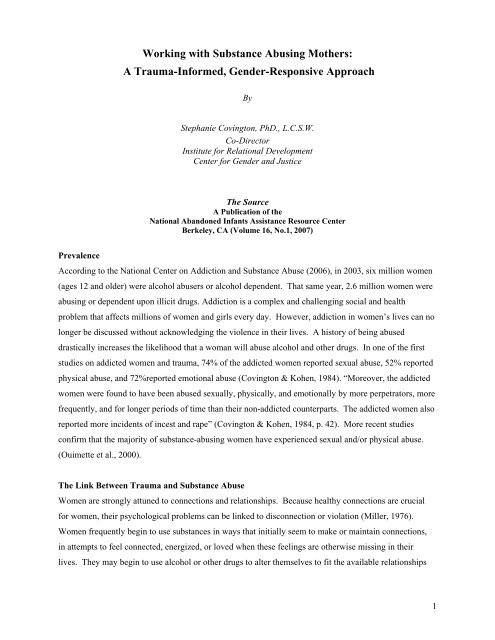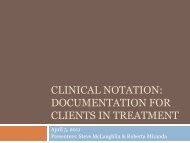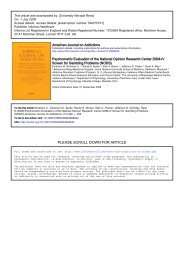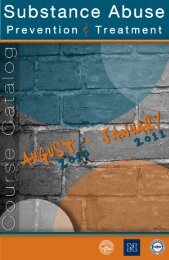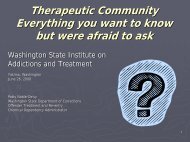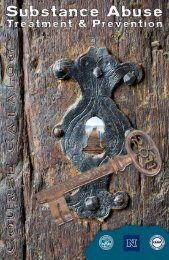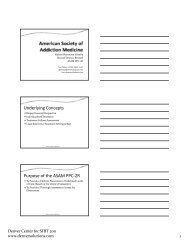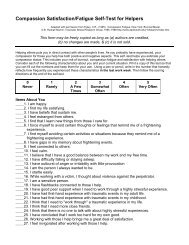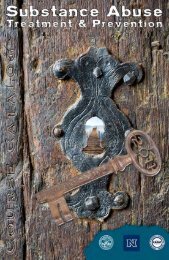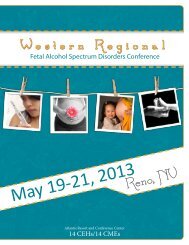Working with Substance Abusing Mothers: A Trauma ... - CASAT
Working with Substance Abusing Mothers: A Trauma ... - CASAT
Working with Substance Abusing Mothers: A Trauma ... - CASAT
You also want an ePaper? Increase the reach of your titles
YUMPU automatically turns print PDFs into web optimized ePapers that Google loves.
<strong>Working</strong> <strong>with</strong> <strong>Substance</strong> <strong>Abusing</strong> <strong>Mothers</strong>:<br />
A <strong>Trauma</strong>-Informed, Gender-Responsive Approach<br />
By<br />
Stephanie Covington, PhD., L.C.S.W.<br />
Co-Director<br />
Institute for Relational Development<br />
Center for Gender and Justice<br />
The Source<br />
A Publication of the<br />
National Abandoned Infants Assistance Resource Center<br />
Berkeley, CA (Volume 16, No.1, 2007)<br />
Prevalence<br />
According to the National Center on Addiction and <strong>Substance</strong> Abuse (2006), in 2003, six million women<br />
(ages 12 and older) were alcohol abusers or alcohol dependent. That same year, 2.6 million women were<br />
abusing or dependent upon illicit drugs. Addiction is a complex and challenging social and health<br />
problem that affects millions of women and girls every day. However, addiction in women’s lives can no<br />
longer be discussed <strong>with</strong>out acknowledging the violence in their lives. A history of being abused<br />
drastically increases the likelihood that a woman will abuse alcohol and other drugs. In one of the first<br />
studies on addicted women and trauma, 74% of the addicted women reported sexual abuse, 52% reported<br />
physical abuse, and 72%reported emotional abuse (Covington & Kohen, 1984). “Moreover, the addicted<br />
women were found to have been abused sexually, physically, and emotionally by more perpetrators, more<br />
frequently, and for longer periods of time than their non-addicted counterparts. The addicted women also<br />
reported more incidents of incest and rape” (Covington & Kohen, 1984, p. 42). More recent studies<br />
confirm that the majority of substance-abusing women have experienced sexual and/or physical abuse.<br />
(Ouimette et al., 2000).<br />
The Link Between <strong>Trauma</strong> and <strong>Substance</strong> Abuse<br />
Women are strongly attuned to connections and relationships. Because healthy connections are crucial<br />
for women, their psychological problems can be linked to disconnection or violation (Miller, 1976).<br />
Women frequently begin to use substances in ways that initially seem to make or maintain connections,<br />
in attempts to feel connected, energized, or loved when these feelings are otherwise missing in their<br />
lives. They may begin to use alcohol or other drugs to alter themselves to fit the available relationships<br />
1
-- typically, in order to please their male partners. They change themselves to maintain the<br />
relationships.<br />
Women also use substances to numb the pain of non-mutual, non-empathic, and violent relationships.<br />
They may turn to substances to provide what their actual relationships are not providing, such as energy,<br />
a sense of power, emotional and physical comfort, and relief from confusion. Addicted women often<br />
are paired <strong>with</strong> men who disappoint them by failing to provide emotional and financial support<br />
(including support for their children) and who wind up in jail. These women take solace from their<br />
disappointment through drug use.<br />
When a woman is disconnected from others (in non-mutual relationships) or involved in abusive or<br />
other traumatic relationships, she experiences a “depressive spiral” that includes diminished vitality,<br />
disempowerment, confusion, diminished self-worth, and a turning away from relationships (Covington<br />
& Surrey, 2000). All these are fertile ground for addiction and relapse and must be addressed in<br />
treatment. Therefore, it is critically important to integrate trauma theory when developing substance<br />
abuse services for women.<br />
Understanding <strong>Trauma</strong><br />
<strong>Trauma</strong> is not limited to suffering violence; it includes witnessing violence as well as stigmatization<br />
because of gender, race, poverty, incarceration, or sexual orientation. The terms violence, trauma, abuse,<br />
and post-traumatic stress disorder (PTSD) often are used interchangeably. One way to clarify these terms<br />
is to think of trauma as a response to violence or some other overwhelmingly negative experience (e.g.,<br />
abuse). <strong>Trauma</strong> is both an event and a particular response to an event. The response is one of<br />
overwhelming fear, helplessness, or horror. PTSD is one type of disorder that results from trauma.<br />
The Diagnostic and Statistical Manual of Mental Disorders (DSM-IV TR) lists the following symptoms<br />
of PTSD (American Psychiatric Association, 2000, p. 427-429):<br />
• Re-experiencing the event through nightmares and flashbacks<br />
• Avoidance of stimuli associated <strong>with</strong> the event (for example, if a woman was assaulted by a blonde<br />
man, she may fear and want to avoid men <strong>with</strong> blonde hair)<br />
• Estrangement (the inability to be emotionally close to anyone)<br />
• Numbing of general responsiveness (feeling nothing most of the time)<br />
• Hypervigilance (constantly scanning one’s environment for danger, whether physical or emotional)<br />
• Exaggerated startle response (a tendency to jump at loud noises or unexpected touch)<br />
2
There are two types of PTSD: simple and complex. Complex PTSD usually results from multiple<br />
incidents of abuse and violence (such as childhood sexual abuse and domestic violence). A single<br />
traumatic incident in adulthood (such as a flood or accident) may result in simple PTSD.<br />
A review of studies that examined the combined effects of post-traumatic stress disorder and substance<br />
abuse found more co-morbid mental disorders, medical problems, psychological symptoms, in-patient<br />
admissions, interpersonal problems, lower levels of functioning, poor compliance <strong>with</strong> aftercare and<br />
motivation for treatment, and other significant life problems (such as homelessness, HIV, domestic<br />
violence, and loss of custody of children) in women <strong>with</strong> both disorders than in women <strong>with</strong> PTSD or<br />
substance abuse alone (Najavits et al.,1997).<br />
There is a difference between women and men in terms of their risk for physical and sexual abuse. Both<br />
female and male children are at relatively equal risk in their childhood from family members and people<br />
known to them. However, as males age, they are more likely to be harmed from enemies or strangers,<br />
whereas women are more likely to be harmed by their lovers or partners (Kendall-Tackett, 2005).<br />
In adolescence, boys are at risk if they are gay, young men of color, or gang members. Their risk is from<br />
people who dislike or hate them. For a young woman, the risk is in her relationships, from the person(s)<br />
to whom she is saying, “I love you.” For an adult man, the risk for abuse comes from being in combat or<br />
being a victim of crime. His risk is from “the enemy,” or from a stranger. For an adult woman, the risk is<br />
again in her relationship <strong>with</strong> the person to whom she says, “I love you.” Clinically, we think that this<br />
may account for the increase in mental health problems for women. In short, it is more confusing and<br />
distressing to have the person who is supposed to love and care for you do harm to you than it is to be<br />
harmed by someone who dislikes you or is a stranger.<br />
Of course, different women have different responses to violence and abuse. Some may respond <strong>with</strong>out<br />
trauma, because they have coping skills that are effective for a specific event. Sometimes trauma occurs<br />
but is not recognized immediately, because the violent event is perceived as normal. Many women who<br />
used to be considered "treatment failures" because they relapsed are now recognized as trauma survivors<br />
who returned to alcohol or other drugs in order to medicate the pain of trauma. By integrating trauma<br />
treatment <strong>with</strong> addiction treatment, we reduce the risk of trauma-based relapse.<br />
3
Impact of <strong>Substance</strong> Abuse and <strong>Trauma</strong> on Mothering<br />
Over the years, evidence indicates that maternal substance abuse is a major contributing factor to child<br />
maltreatment. Addicted mothers are less often able to provide adequate shelter, care, and economic<br />
stability for their children. Further, the impaired judgment and emotional instability associated <strong>with</strong><br />
substance abuse contribute to the risk of child abuse. Although estimates of the prevalence of substance<br />
abuse problems among parents (the majority are mothers) who have contact <strong>with</strong> the child welfare system<br />
vary, the range is from half to 80% (Grella et al., 2006).<br />
What is less well understood is the impact of trauma on a woman’s capacity to mother. The wounded<br />
mother is often the blamed mother. For many of these women, mothering means struggling to parent<br />
your child while at the same time struggling to recover. A history of past trauma can affect how a woman<br />
experiences parenting and how effective she is as a parent. There are several major parenting issues for<br />
trauma survivors:<br />
• Feelings of shame, guilt, and inadequacy can interfere <strong>with</strong> parenting.<br />
• Interaction <strong>with</strong> a child can trigger a mother’s traumatic past.<br />
• The mothers are at risk of becoming overprotective of their children.<br />
• At the other extreme, they may be neglectful in order to avoid being “triggered” by their<br />
children.<br />
• Addicted mothers may have been inadequately nurtured themselves.<br />
Addiction programs for women who have children should include education in parenting and child<br />
development and interventions that address relationships <strong>with</strong> and reunification <strong>with</strong> their children.<br />
Many addicted women are more motivated to enter treatment and become abstinent when they become<br />
pregnant. (Hankin, McGaul, & Heussner., 2000). This often is an opportune time to intervene <strong>with</strong> them.<br />
However, the challenge is for the woman to remain clean and sober after giving birth.<br />
Becoming <strong>Trauma</strong>-Informed<br />
As the understanding of and appreciation for traumatic experiences increases among clinicians, mental<br />
health theories and practices are changing. It is important for service providers to understand trauma<br />
theory as a conceptual framework for clinical practice and to provide trauma-informed services for their<br />
clients. According to Harris and Fallot (2001), trauma-informed services do the following:<br />
• Take the trauma into account<br />
• Avoid triggering trauma reactions or retraumatizing the woman<br />
4
• Adjust the behavior of counselors and staff members to support the woman’s coping capacity<br />
• Allow survivors to manage their trauma symptoms successfully so that they are able to access, retain,<br />
and benefit from the services<br />
For treatment providers who want to include or expand trauma services, the following model provides a<br />
description of how to integrate trauma-informed services and trauma treatment into addiction treatment<br />
programs.<br />
A Three-Stage Model for <strong>Trauma</strong> Recovery<br />
In <strong>Trauma</strong> and Recovery, psychiatrist Judith Herman (1997) defines trauma as a disease of disconnection.<br />
She presents a three-stage model for trauma recovery: 1) safety, 2) remembrance and mourning, and 3)<br />
reconnection. It is important to note that these three stages are interdependent and usually do not occur in<br />
a linear fashion.<br />
Stage 1 - Safety<br />
Stage 1 - safety -, focuses on caring for oneself in the present. On entering addiction treatment, a woman<br />
typically is in Stage 1 and her primary need is safety. “Survivors feel unsafe in their bodies. Their<br />
emotions and their thinking feel out of control. Often, they also feel unsafe in relation to other people”<br />
(Herman, 1997, p. 160).<br />
If we want to assist women in changing their lives, we must create a safe environment in which the<br />
healing process can begin to take place. Counselors can help women to feel safe by ensuring as much as<br />
possible that there are appropriate boundaries between the clients and all the helping professionals (that is,<br />
the environment is free of physical, emotional, and sexual harassment and abuse). Although it may be<br />
possible for a clinician to guarantee absolute safety only in a private practice setting, participants in<br />
treatment programs need to know that the environment is likely to be safe for them. Counselors also<br />
should assess each woman’s risk of domestic violence and, if needed, provide resources to a woman so<br />
that she can get help. These resources include telephone numbers for the local domestic violence hotline<br />
and the local women’s shelter.<br />
Many chemically dependent trauma survivors use drugs to medicate their anxiety or depression because<br />
they know no better ways to comfort themselves. Counselors can teach women to feel safe internally by<br />
teaching them to use self-soothing techniques, rather than drugs, to alleviate anxiety and depression. Selfsoothing<br />
can include activities such as reading, walking, music, meditation, and bubble baths.<br />
5
Understanding the impact of trauma is particularly important for women who have had criminal justice<br />
involvement. Unfortunately, standard practices – such as searches, seclusions, and restraint – may<br />
traumatize or retraumatize many females. Experiences in the criminal justice system can trigger<br />
memories of earlier abuse. It can be retraumatizing when a survivor of sexual abuse has a body search or<br />
must shower <strong>with</strong> male correctional officers nearby. It can also be retraumatizing when a battered woman<br />
is yelled at or cursed at by a staff person. Incarceration can be traumatizing in itself, and the racism and<br />
class discrimination that are characteristics of the criminal justice system can be further traumatizing.<br />
Herman (1997) emphasizes that a trauma survivor who is working on safety issues needs to be in a<br />
woman-only recovery group (including the facilitator). Until they are in Stage 3 (reconnection), women<br />
may not want to talk about sensitive issues in groups that include men. Herman (1997) cites Twelve Step<br />
groups as the type appropriate for Stage 1 (safety) recovery because of their focus on present-tense issues<br />
of self-care in a supportive, structured environment. This safety stage focuses on issues that are<br />
congruent <strong>with</strong> the issues of beginning recovery.<br />
Stage 2 - Remembrance and Mourning<br />
A woman who is stabilized in her addiction treatment may be ready to begin Stage 2 trauma work. Stage<br />
2, remembrance and mourning, focuses on trauma that occurred in the past. For example, in a survivors’<br />
group, participants tell their stories of trauma and mourn their old selves, which the trauma destroyed.<br />
During this phase, women often begin to acknowledge the incredible amount of loss in their lives.<br />
Although the risk of relapse can be high during this phase of work, the risk can be minimized through<br />
anticipation, planning, and the development of self-soothing mechanisms.<br />
Stage 3 - Reconnection<br />
This stage focuses on developing a new self and creating a new future. Stage 3 groups traditionally are<br />
unstructured and heterogeneous. This phase of trauma recovery corresponds to the ongoing recovery<br />
phase of addiction treatment. For some women, this work can occur only after several years of recovery.<br />
The <strong>Trauma</strong>-informed Environment<br />
In women's treatment programs, sensitivity to trauma-related issues is critical for a healing environment.<br />
A calm atmosphere that respects privacy and maximizes the choices a woman can make will promote<br />
healing. Staff members should be trained to recognize the effects of trauma, and clients should have a<br />
clear understanding of the rules and policies of the program. A trauma-informed environment includes:<br />
6
• Attention to boundaries – between staff members and participants, among participants, and among<br />
participants and visitors. For example, clients should be given permission to say “no” to hugs.<br />
Hugging may be an expression of positive emotion for some women, but for those who have been<br />
traumatized it could represent an undesired intrusion into their personal spaces.<br />
• Language that communicates the values of empowerment and recovery. Punitive approaches,<br />
shaming techniques, and intrusive monitoring are not appropriate. Staff members who adopt the “do<br />
no harm” credo to avoid damaging interactions. Conflict is dealt <strong>with</strong> through negotiation.<br />
Creating Programs for Women and Girls<br />
When developing addiction treatment for women and girls, research demonstrates that services need to be<br />
provided in a holistic and woman-centered approach. Gender-responsive/woman-centered services can be<br />
defined as the creation of an environment – through site selection, staff selection, program development,<br />
and program content and materials – that reflects an understanding of the realities of women’s and girls’<br />
lives and that addresses and responds to their challenges and strengths. The holistic model of treatment<br />
works to understand every aspect – physical, emotional, and spiritual – of the woman’s self, as well as the<br />
environmental and sociopolitical aspects of her life, in order to understand her addiction. An addicted<br />
woman typically is not using alcohol or other drugs in isolation, so we take into account her relationships<br />
<strong>with</strong> her family members and other loved ones, her local community, and society. The link between<br />
understanding women’s addiction and creating effective treatment programs for women lies in<br />
understanding the unique characteristics of women’s psychological development and needs.<br />
In addition, a woman’s relationship <strong>with</strong> her children and her identity as a mother often are major clinical<br />
issues. Treatment needs to address the critical issue of parenting and connections to children. There<br />
needs to be a full range of services for children, either in the program or by referral to a collaborating<br />
agency. Women who have not adequately cared for their children or who are perceived as neglecting<br />
their children carry a tremendous amount of guilt. Further, their children often need therapeutic services<br />
designed for children <strong>with</strong> addicted mothers, in addition to adequate care.<br />
In developing gender-responsive services, one important ingredient is the curriculum/material used. The<br />
following are three manualized curricula that are designed for working <strong>with</strong> women and girls. They are<br />
theoretically-based and trauma-informed, each <strong>with</strong> a facilitator’s guide and a participant’s workbook.<br />
They use cognitive-behavioral, relational, and expressive arts techniques.<br />
7
Helping Women Recover: A Program for Treating Addiction<br />
The three theories of addiction, trauma, and women’s psychological development create the foundation of<br />
the 17-session program. The four modules focus on the issues of: Self, Relationship, Sexuality, and<br />
Spirituality (Covington, 1999).<br />
Voices: A Program of Self-Discovery and Empowerment for Girls<br />
This is the girl’s version of Helping Women Recover. There are 18 sessions <strong>with</strong> four modules: Self,<br />
Connecting <strong>with</strong> Others, Healthy Living, and .The Journey Ahead. The foundation of this program<br />
material is based on the three theories mentioned above, <strong>with</strong> the addition of resiliency theory and<br />
attachment theory (Covington, 2004).<br />
Beyond <strong>Trauma</strong>: A Healing Journey for Women<br />
This 11-session program focuses on three areas: teaching women what trauma and abuse are; helping<br />
them to understand typical reactions; and developing coping skills. The foundation of this material is the<br />
work of Judith Herman and several other trauma theorists (Covington, 2003).<br />
A study of Helping Women Recover and Beyond <strong>Trauma</strong>, <strong>with</strong> women in a residential program <strong>with</strong> their<br />
children, demonstrated a decrease in depression (using Beck’s Inventory) and trauma symptoms (using<br />
the <strong>Trauma</strong> Symptom – 40 Scale) (Miller, 1976).<br />
8
The study also found improvements in the women’s perceptions in terms of mothering. These women felt<br />
less guilty as mothers and were more comfortable in asking for help <strong>with</strong> parenting skills. They also<br />
believed more strongly that understanding their own childhoods helped them to be better parents and that<br />
their children were safe in their care.<br />
Conclusion<br />
The following are suggestions of what we each can do as we work <strong>with</strong> women and their families:<br />
• Create gender-responsive services.<br />
As we look through the lens of women’s lives, the issues reflected back to us are a guide to our<br />
work. These issues (e.g., substance abuse, trauma, poverty, mental illness, HIV/AIDS,<br />
homelessness, etc.) indicate where our focus needs to be.<br />
• Invest in women.<br />
We can learn from developing countries. They have found that investing money in women’s<br />
lives is the best way to support families.<br />
• Become trauma-informed.<br />
Learn about the impact of violence on women and children. Then adjust and modify our services<br />
to reflect this understanding.<br />
9
• Reflect on our attitudes and beliefs about mothers.<br />
Mother-blaming has been part of women’s experience for generations. Society needs to look at<br />
the expectations placed on women who are struggling <strong>with</strong> multiple issues and assess their “level<br />
of burden” (Brown et al., 1995) before we judge them. Many of those who are struggling to<br />
parent are women who may not have been mothered themselves.<br />
NOTE: This article is adapted from Women and Addiction: A Gender-Responsive Approach<br />
(Covington, 2007) which is part of the Hazelden Clinical Innovator’s Series. There is a manual<br />
for clinicians <strong>with</strong> an accompanying DVD and CEU credits.<br />
10
References<br />
American Psychiatric Association. (2000). Diagnostic and statistical manual of mental disorders (4th ed.,<br />
text revision). Washington, DC: Author.<br />
Brown, V., Huba, G., & Melchior, L. (1995). Level of burden: Women <strong>with</strong> more than one co-occurring<br />
disorder. Journal of Psychoactive Drugs, 27(4), 339-345.<br />
Covington, S. (1999). Helping women recover: A program for treating addiction. San Francisco: Jossey-<br />
Bass.<br />
Covington, S. (2003). Beyond trauma: A healing journey for women. Center City, MN: Hazelden<br />
Covington, S. (2004). Voices: A program of self-discovery and empowerment for girls. Carson City, NV:<br />
The Change Companies.<br />
Covington, S. (2007). Women and addiction: A gender-responsive approach. Center City, MN: Hazelden.<br />
Covington. S, & Kohen, J. (1984). Women, alcohol, and sexuality. Advances in Alcohol and <strong>Substance</strong><br />
Abuse, 4(1), 41-56.<br />
Covington, S., & Surrey, J. (2000). The relational model of women’s psychological development:<br />
Implications for substance abuse. Work in Progress, No.91. Wellesley, MA: Stone Center <strong>Working</strong> Paper<br />
Series.<br />
Grella, C., Hser, Y., & Huang, Y. (2006). <strong>Mothers</strong> in substance abuse treatment:<br />
Differences in characteristics based on involvement <strong>with</strong> child welfare services. Child Abuse & Neglect,<br />
30(1), 55-73.<br />
Hankin, J., McCaul, M.E., and Heussner, J. (2000). Pregnant, alcohol-abusing women. Alcoholism:<br />
Clinical and Experimental Research 24(8): 1276-1286.<br />
Harris, M, & Fallot, R. (2001). Using trauma theory to design service systems. San<br />
Francisco: Jossey-Bass.<br />
Herman, J. (1997). <strong>Trauma</strong> and recovery. New York: HarperCollins.<br />
Kendall-Tackett, K. (2005). Introduction: Women’s experiences of stress and trauma. In K. Kendall-<br />
Tackett (Ed.), Handbook of women, stress and trauma. New York, NY: Brunner-Routledge. pp. 1-5.<br />
Miller, J. B. (1976). Toward a new psychology of women. Boston: Beacon Press.<br />
Najavits, L., Weiss, R., & Shaw, S. (1997) The link between substance abuse and posttraumatic stress<br />
disorder in women: A research review. American Journal on Addictions, 6(4), 273-283.<br />
Ouimette, P.C., Kimerling, R., Shaw, J., and Moos, R.H. (2000). Physical and sexual abuse among<br />
women and men <strong>with</strong> substance use disorders. Alcoholism Treatment Quarterly 18(3):7-17.<br />
The National Center on Addiction and <strong>Substance</strong> Abuse (CASA) at Columbia University. (2006) Women<br />
under the influence. Baltimore, MD: John Hopkins University Press.<br />
11


